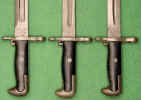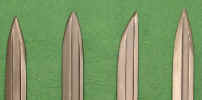November 2002
There seems to be quite a bit of interest in the M1 bayonet these days, possibly due to the recent movies about WW2 and the M1 rifles and M1903 rifles being sold by the CMP. I receive a number of questions about this bayonet, and it seems to be a hot topic of question and discussion on the forums. So I thought I would take make a few comments on a somewhat misunderstood variation of the M1 bayonet.
The US entered World War 2 still using the 16 inch blade M1905 bayonet that had been used in the First World War, and in fact contracted for over 1 1/2 million more in 1942-43. Many of the other nations at war had adopted a shorter bladed bayonet, and on August 22, 1942 a request was made by the Cavalry Board for a shorter blade as being easier to carry on the belt while mounted, in vehicles and for emergency use as a hand weapon. Bayonets with a 10-inch blade were provided to various units and boards for testing in early 1943 as the Bayonet, M1905E1. Opinions from the using services were nearly unanimous in favor of the shorter blade, and it was also realized that manufacturing the shorter blade would save a large amount of steel. Accordingly, the Bayonet M1 was adopted on March 1, 1943.
Although I generally don't like using incorrect nomenclature, at times a "collector designation" does prove useful. Collectors use the term M1905E1 for all those M1905 16 inch blade bayonets shortened to 10 inch blades. However, officially the terminology of M1905E1 was applied only to those bayonets used in the tests, not to the bayonets that were shortened subsequently to 10-inch blade length. But since there is no better name for the shortened bayonets, and since the term M1905E1 is consistently used for this type, I don't feel that it causes any problems.
It must be remembered that when the shortened bayonet entered military inventory, it did so as a Bayonet, M1. The army made no attempt to differentiate between the M1 bayonet and the shortened M1905s, and they were issued indiscriminately. As early as the October 1943 issue of TM9-2200 (Small Arms, Light Field Mortars, and 20-mm Aircraft Guns) the shortened version was used in the illustration of the Bayonet M1. In fact, almost every other manual such as the June 1944 Handbook of Ordnance Material and the April 1949 edition of TM 9-2200 (by then titled Small Arms Material and Associated Equipment) use the M1905E1 for their illustration of the M1 bayonet.
Some collectors feel that the shortened bayonet did not enter service until too late to see much active combat in WW2, and that the regular M1 bayonet is the most correct one to go with their M1 or M1903 series rifle. But the M1905E1 entered Ordnance channels in September 1943 and by the end of 1943 over 225,000 had entered the supply system, so the shortened type is certainly appropriate for any 1944 or later rifle.
The point shape of the M1905E1 is another story. Originally the plan was to shape the point of the newly shortened blade to what it had been - a spear point. But it was soon found that this could cause a problem, especially with the Model of 1905 bayonets, and some of the early 1942 contract production, which had what is termed a "square" fuller. In these (see photo below), the fuller is fairly wide, flat on the bottom, and rises steeply on each side into the blade. The left specimen is an early Utica Cutlery which has the square fuller. The center is a Pal Blade Co. with a wide round fuller in which the shape is a semi-circle, and on the right is an American Fork and Hoe with a narrow round fuller. Most WW2 production used the round fuller, although Oneida, Pal, Union Fork and Hoe, and Utica all made some with square fullers early in their production. I do not have an AFH or Wilde Tool in my reference collection with a square fuller, but they may have been made.

Click on Photo for full size view.
When bayonets with square fullers were converted to a spear point, it left a fairly wide thin area just at the point, which was easily bent or damaged. Bayonets, Knives & Scabbards, United States Edged Weapons Report 1917-1945 (available from Frank who edited this report and published it for collectors Click here to obtain a copy ) states: "Union Fork and Hoe Company undertook a comparative study of rectangular blood grooves and round blood grooves of M1905 bayonets, which was submitted to Springfield Armory, along with ten modified bayonets from each facility, for their study and tests, in order that the practicability of converting the square groove type might be determined."
The final result of these tests was a recommendation that the point shape of the bayonets that were to be shortened from those with square fullers be changed from a spear point to a beak point (commonly but incorrectly called a "bowie" point by many collectors today). By curving the new point shape all the way from the true edge to the back, extra metal was given to the point, greatly strengthening it. As the shortening program had already begun, some bayonets with square fullers can be found with spear points, and even rarely (and probably accidentally) a round fuller with a beak point. Again, it must be remembered that all of these bayonets were in inventory as Bayonet M1, regardless of the point shape.
In the photo below, the left point is a 1942 dated UC, in which the square fuller is fairly centered in the blade. It can readily be seen that there is little metal around the point, making it thin and readily damaged. This is the primary reason that this style of shortening was abandoned and the beak point introduced.
The second point is on a 1942 Oneida with a square fuller. This one, unlike the UFH, has the fuller closer to the back, and this results in more metal around the point as the thicker area continues almost to the more rounded point.
The third point is a Rock Island Model 1905 shortened to the standard beak point. Note that there is little or no false edge, as reducing metal in this area would weaken the point. Some are found with a rudimentary false edge ground to the back, and others rarely with a full 3 or 4-inch false edge. Grinding such a false edge in the back severely weakens the point and was not standard procedure. This is often called a "bowie" point by collectors and seems
The last point is a 1943 dated AFH with a round fuller. Even though this was ground to a fairly sharp point, and a false edge added, there is obviously considerably more metal to strengthen the point area.

Click on Photo for full size view.
All five of the contractors for the M1 bayonet participated in the shortening program. As an example of the cost of modification, The Digest of Significant Purchase Actions lists contract W-30-115ORD 4028 issued to Union Fork and Hoe for Modification of Bayonet from Model 1905 to M1. The contract was issued on April 19, 1945 for 100,000 units at $1.42 each, with the work to be completed by December 1945. This contract was cancelled in August 1945 with about 50,000 delivered. A note mentioned that this was a new award with a previous award price of $1.36. Most contractors probably received about the same price for this work. Besides shortening the blade and refinishing the metal, damaged parts such as grips, catches and even guards were replaced as necessary.
Each marked the bayonet to show who did the work. AFH stamped their mark on the upper back of the tang, as did UFH for a short time. Most markings are found on the right ricasso such as U.F.H., OL (apparently with individual stamps), PAL-MOD, and U.C.-MOD. Some of them are found with no mark to show what company shortened them. One theory is that these were shortened before an order went out requiring them to be marked, or they were shortened before delivery.
As a side note, the Springfield Armory Report of Articles Fabricated, Modified and Overhauled During the Fiscal Year 1944 shows 33,200 Mod. (Modified?) Bayonet, M1905 & M1. This may indicate that Springfield shortened some bayonets and did not mark them.

Click on Photo for full size view.
Returning the long bayonets to the contractors for shortening was on an intermittent basis resulting in periods of time in which there were few bayonets to be modified. Some of the contractors, notably Oneida, asked to be released from their contracts, as they could not keep their workmen employed on a steady basis. Oneida was dropped from the program in November 1943, and bayonets with the OL mark are probably the hardest to find. Utica and Pal were dropped in 1944 when it was found that Union Fork and Hoe and American Fork and Hoe could keep up with the supply of bayonets to be shortened.
There was an unknown amount of loss/wastage during the process, enough that the Bayonets, Knives and Scabbards report mentioned above stated: "..the slow rate at which bayonets were being received, together with the high scrappage rate, was making the modification program very disappointing." The variety of steels used in the bayonets, plus the differing fuller shapes made the process slower and more difficult than had first been expected.
As mentioned earlier, deliveries of the modified bayonets began in September 1943 and continued until August of 1945. Deliveries averaged about 40-50 thousand per month, with a total recorded delivery of 1,007, 671 according to Bayonets, Knives and Scabbards - United States Army Edged Weapons Report 1917 thru 1945. This total may not include those shortened by Springfield Armory (if indeed that is what was done) as mentioned above.
Scabbards were also modified, but this will be the subject of a future column.
Return to Bayonet Points Index